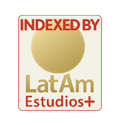The Power of The (un)seen
The Ellipsis as A Political Strategy of Representation
DOI:
https://doi.org/10.24215/24691488e119Keywords:
Latin America, women’s representation, ellipsis, installationAbstract
Based on the analysis of the installations Puente Kyha by Claudia Cassarino, Desapego by Celeste Massin and Blisters del cuerpo by Patricia Hakim, this work seeks to explore the power of ellipsis as a response to the representation of women in western civilization art. The generalized meaning of ellipsis refers to the intentional omission of certain elements of discourse to provoke effects in the viewer. However, in a context in which the nude has been the most commonly used genre to represent or portray women, the decision to depict a female body but not in an explicit way works as a political strategy of representation, like a response to the «hypervisibility of women as objects of representation and their persistent invisibility as creative subjects» (Mayayo, 2003, p. 21).Downloads
References
Acaso, M. (2009). El lenguaje visual. Editorial Paidós.
Berger, J. (2000). Modos de ver. Editorial Gustavo Gili S.A.
Casarino, C. (s. f.). Página web de la artista. https://www.claudiacasarino.com/es
Ciafardo, M. (2020). La enseñanza del lenguaje visual: bases para la construcción de una propuesta alternativa. Papel Cosido.
Durand, J. (1972). Retórica e imagen publicitaria. En Ch. Metz y otros, Análisis de las imágenes (pp. 81-115). Editorial Tiempo Contemporáneo.
Geat, A. (2020). Lo personal es artístico. Cuestiones de género y feminismo en las artes visuales del Nordeste argentino [Tesis doctoral inédita, Universidad Nacional de Córdoba].
Giunta, A. (2017). Artistas mujeres en América Latina. Notas para un análisis político de las imágenes. Atlántica, 58(3), 1-4. https://ri.conicet.gov.ar/handle/11336/82538
Gluzman, G. (2013). El vértigo de lo lento de Mónica Millán: presentar mundos. Caiana, Revista de Historia del Arte y Cultura Visual del Centro Argentino de Investigadores de Arte (CAIA), 2, 1-13. https://caiana.caiana.com.ar/wp-content/uploads/2023/03/gluzman-1.pdf
Hakim, P. (s. f.). Página web de la artista. https://patriciahakim.com.ar
Massin, C. (s. f.). Página web de la artista. https://celestemassin.wixsite.com/celestemassin
Mayayo, P. (2003). Historias de mujeres, historias del arte. Editorial Cátedra.
Nead, L. (2013). El desnudo femenino. Arte, obscenidad y sexualidad. Tecnos / Alianza. Traducción de Carmen González Martín.
Olmedo Barchello, S. M., Achinelli Báez, M. F. y Ayala Alfonso, D. E. (2016). Asociatividad en las mujeres tejedoras paraguayas en el distrito de Yataity, Guairá, Paraguay. Revista Internacional de Investigación en Ciencias Sociales, 12(1), 43-60. https://doi.org/10.18004/riics.2016.julio.43-60
Downloads
Published
How to Cite
Issue
Section
License

This work is licensed under a Creative Commons Attribution-NonCommercial-ShareAlike 4.0 International License.
The acceptance of the manuscript by the magazine means the non-exclusive cession of the property rights of the authors in favour of the editor, who allows the reuse, after publication (post print), under a license Attribution-NonCommercial-NoDerivatives 4.0 International. According to these terms, the material can be copied and redistributed by any means or in any format as long as a) the author and original source of the publication are quoted (magazine and URL of the work), access to the license is provided and whether changes have been made is mentioned; and b) the material is not used for commercial purposes.
The cession of non-exclusive rights means that after the publication (post print) in Arte e Investigación the authors can publish their work in any language, means and format; in such cases it must be mentioned that the material was originally published in this magazine. Such cession also means the authorization of the authors for the work to be collected by SEDICI, the institutional archive of the National University of La Plata, and to be spread in the databases that the editorial team considers appropriate to increase the visibility of the publication and its authors.
Moreover, the magazine encourages the authors to deposit their productions in other institutional and thematic archives under the principle that offering the society the scientific and academic production without any restrictions contributes to a greater exchange of the global knowledge.

































